Jason Schneider
the Camera Collector
12 Great Buys in Vintage Film Cameras:
These superb user-collectibles offer real value for users and collectors.
By Jason Schneider
One of my great pasions is shooting pictures on black-and-white film with vintage cameras. Based on my 50+years of doing just that I’ve checked out the prices and formulated value per dollar estimates of some of the best vintage shooters currently posted by camera dealers and on the major online selling sites, and have come up with the list below. It don’t pretend that my list is exhaustive (I’m sure many of you could come up with alternative lists), but it has the advantages of being hearfelt and based on extensive hands-on experience. I hope you enjoy it and find it useful—please let me know.
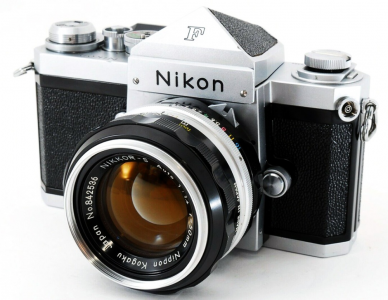
Original early Nikon F shown with plain prism and later c.1970 50mm f/1.4 Auto Nikkor-S lens. It's a timeless classic and a great shooter.
Nikon F 1959. The legendary Nikon F was the first truly professional caliber SLR, and was conceived as the basis for a high quality professional SLR system. The Nikon F remained in production, with relatively minor changes, for nearly 14 years, and during that time it established Nikon as the leading professional 35mm camera. A handsome, rugged, reliable machine of modular design, its removable pentaprism and external meter-coupling system allowed the Nikon F to be retrofitted with the latest advances in metering technology by upgrading the meter prism, and its F mount has endured, with some operational changes, up to the present digital era—a remarkable example of non-obsolescence. While the Nikon F is not really a technological landmark it marked the coming of age of the 35mm SLR. Its features include: Titanium foil focal-plane shutter (early models had cloth shutters) with speeds from 1-1/1000 sec plus B and T, interchangeable finders and screens, and a removable back. An extensive range of lenses and specialized accessories is available. The Nikon F is a superb user-collectible, and these days you can snag a clean functional example in chrome with FT or FTn meter prism and 50mm f/1.4 Nikkor-S lens for only $150 to $250. A pristine early (1959 to 1962) Nikon F with non-TTL “flag type” meter prism and original 5.8cm f/1.4 Nikkor lens typically runs about $800-1000; and very early models with cloth shutter, and not modified to take the later meter prisms are rarer and even pricier.
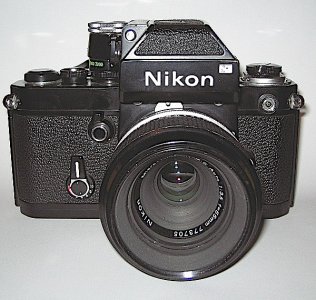
Nikon F2 Photomic with DP-1 prism and 55mm f/3.5 Micro-Nikkor. lens. Many experts say it was the finest all mechanical manual focus Nikon.
Nikon F2 (1971 to 1980). Widely regarded as the best all metal, fully. mechanically controlled manual focus 35mm SLR Nikon ever made, the Nikon F2 has a horizontal travel, titanium foil focal plane shutter with speeds of 1-1/2000 sec plus B and T, stepless intermediate speed settings possible from 1/80 to 1/2000 sec, and slow speeds of 2 to 10 sec available via the B setting by using the self-timer. It also has a more convenient hinged, detachable back, and a more secure prism mounting system. The F2 Photomic with DP-1 prism finder privides TTL center-weighted, center-the-needle readings at full aperture plus stopdown metering and uses CdS cells powered by two 1.5v silver-oxide batteries. The Nikon F2S with DP-2 prism finder employs improved CdS cells, reads out the exposure using 2 signal lights in place of a needle, has a top-mounted flash ready light, and a contact for an EE aperture control unit. The Nikon F2SB uses two memory-lag-free SBC meter cells, reads out via a 3-LED display with 5 exposure gradations, is cross coupled to both aoerture and shutter speed controls, and displays cirrect exposure in a top panel when the eyepiece blnd is closed. The Nikon F2A and F2AS have Nikon DP-11 and DP-12 meter prisms respectovely, both of which work with later Nikkor lenses that privde auto maximum aperture indexing. The Nikon F2AS is the last and best of the line, with SBC cells, LED readouts, and the ability to read diwn to -4EV at ISO 100 with the f/1.4 lens. Current price ranges for very clean fully functional Nikon F2s in chrome or black: with plain prism, $250-300, Nikon F2A with DP-11 prism, $300-$350, F2AS with 50mm f/1.4, $350-$450, Nikonn F2T (Titanium), $1,200-$1,500, body only or with 50mm f/2 Nikkor.
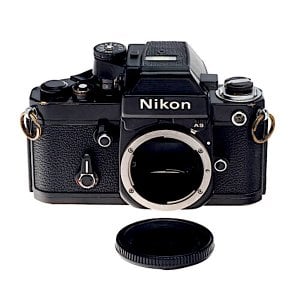
Nikon F2 AS, acclaimed as the last and best of the line. It had a very sensitive SBC cell meter prism and brilliant segmented LED readouts.
Topcon RE Super (1963) Sold in the U.S. as the Beseler Topcon Super D it was the first 35mm SLR with through-the-lens match-needle metering, manufactured by Tokyo Optical Company, Ltd. and initiated the basic trend that all other SLR makers were destined to follow. The RE Super was unique in having its CdS meter cell built into the mirror, permitting the use of simple interchangeable optical finders, but this system, designed in a joint project with Toshiba Electric Co., proved complex and expensive to produce. The RE was eclipsed one year later by the Pentax Spotmatic, which took TTL readings off the viewing screen, a simpler system adopted by virtually every other maker. Large, robust, and nicely finished, the Topcon RE Super features include; Interchangeable eye-level pentaprism and finder screens, single-stroke wind lever, full-aperture metering, cloth focal-plane shutter with speeds from 1-1/1000 sec plus B, winder/motor compatibility, and Exakta-compatible bayonet mount. Standard lens is the magnificecent 58mm f/1.4 R.E. Auto Topcor. The RE Super was produced in four versions and provided the basis for the Topcon D-1 and Super DM that remained in production until the ‘80s. A clean original Topcon or Beseler Topcon RE Super or Super D in chrome with 58mm f/1.4 lens sells for around $350-$500, but is more commonly paired with the outstsanding 58mm f/1.8 Topcor, a combo that typically fetches $200-$275.00. Note: these cameras were deigned to use out of production 1.35v mercuric oxide batteries and must be converted to meter properly with current 1.5v akaline or silver oxide cells.
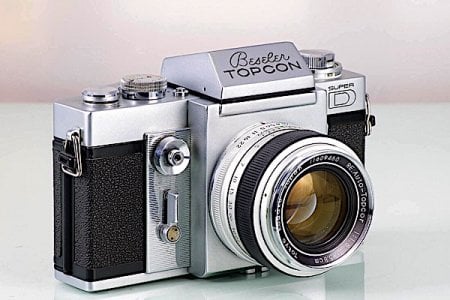
Beseler Topcon Suoer D with outstanding 5.8cm f/1.8 R.E. Auto-Topcor lens. The 5.8cm f/1.4 R.E. Auto-Topcor is legendary, but this combo typically costs a lot less.
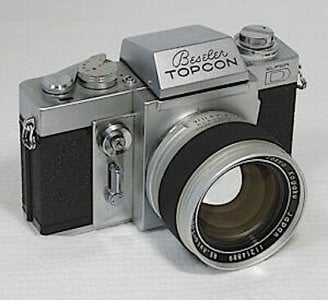
Beseler Topcon Super D with superlative 5.8cm f/1.4 R.E. Auto-Topcor lens noted for its amazing combination of sharpness, gorgeous rendition, add lovely natural bokeh.
Mamiyaflex C (1956) The first of the Mamiyaflex C-series, the only interchangeable-lens, 6x6cm (2-1/4 square) twin-lens reflex cameras that were a real commercial success, it established the basic design. All feature removable lens sets, consisting of taking and viewing lenses attached to an abbreviated lensboard.. Like all C-series Mamiyaflexes, the original C is a rugged, durable, professional caliber camera with rack-and-pinion knob focusing and a bellows behind the lensboard. It also features knob wind (changed to a crank on later models) waist-level viewing (eye-level mirror prisms were later offered) and an outstanding 5-element, 3-group 80mm f/2.8 Mamiya-Sekor normal lens in a Seikosha-MX 1-1/400 sec shutter. Alternative focal-length lens sets included 65mm 105mm 135mm and 180mm—later, a 55mm and 250mm. The last of the breed, the Mamiya C330S, was discontinued in 1993. The Mamiyaflex C and the nearly identical C2 lack double exposure prevemtion, and only have parallax indication, not correction like postwar Rolleiflex TLRs, but they’re fine-performing user cameras. Note: those with lenses incorporporating the Seikosha-MX 1-1/400 sec shutter have 11-bladed diaphragms resulting in smoother bokeh; later lenses, like all postwar Rolleiflex TLRs, have 5-bladed diaphragms. Clean fully working examples of the Mamiyaflex C and C2 with 80mm or 105mm lens set currently go for an enticing $125 to $225.
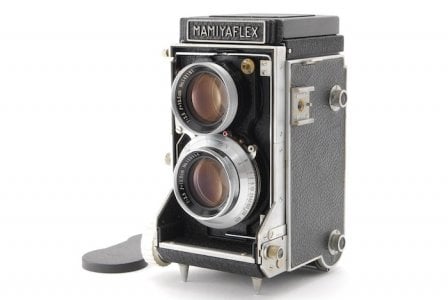
Mamiyaflex C orginal 1956 model with distinctive pointy "feet" on base, amd 10.5cm f/3.5 lens set. Early lenses in Sekosha MX shutters have 11-bladed diaphragms.
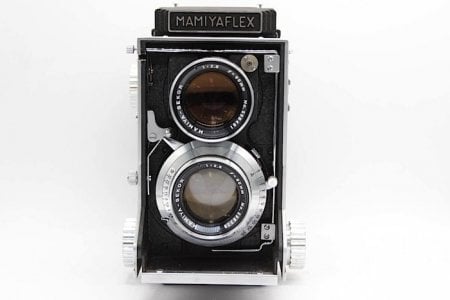
Mamiyaflex C2 with flat bottom, dual focusing knobs , and later 80mm f/2.8 Mamiya-Sekor lens with 1/500 sec Seiko shutter.
Ricoh Diacord G: Introduced in 1958 to compete with the immensely popular Yashica-Mat, this unsung classic performs just as well, albeit with a film wind knob intead of a film wind crank. Its signature feature is a “see-saw” double-ended focusing lever that provides efficient “two finger” manual focusing down to a marked 3.5 feet (it actually gets diwn to about 3 feet) and its reflex finder is bright and crisp. The viewing lens is a 3-element, 3-group 80mm f/3.5 Ricoh Viewer and the taking lens is an excellent 80mm f/3.5 Rikenon, a 4-element, 3-group Tessar design that stops down to f/22 (even though the manual says f/16.) Both lenses are fitted with bayonet flanges and accept Series 1 Rolleinar close-up sets. The shutter is a Citizen MV or MXV both prividing speeds of 1-1/400 sec plus B. Note: This camera was available with a few different nameplates, not all of which say Diacord (a contraction denoting Diamond top-level series and Cord taken from Rolleicord). Some are fitted with 3-element Riconar taking lenses, so make sure the one you acquire has the superior 80mm f/3.5 Rikenon. Long neglected, these cameras have lately attracted a small but devoted following, resulting in higher prices. Current price range for a pristine example wigth cap and case: $135-$200. Note: The later Rcoh Diacord L is basically the same camera with a built-in uncoupled meter with a side-munted readout index and a selenium cell with cover above the viewing lens. It’s a very good camera, but not as elegant as the meterless Diacird G and it sells for up to $250 or so.
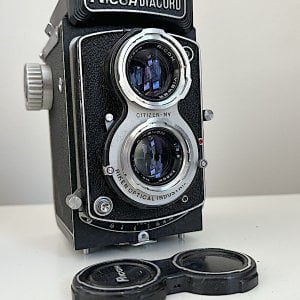
Ricoh Diacord G with 80mm f/3.5 Rikenon taking lens in Citizen MV 1/1/400 sec plus B shutter. Note "see-saw" two finger focusing levers.
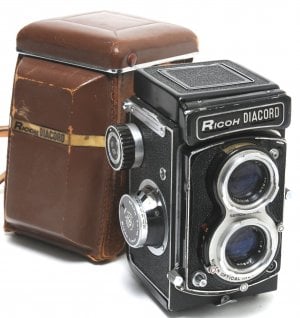
Ricoh Diacord L with built-in selenium meter, Seikosha MXL 1-1/500 sec plus B shutter. It's not as elegant as the Ricoh Diacord G, and pricier.
Konica IIIA (1958) Perhaps the finest, most advanced example of the meterless, leaf shutter Japanese rangefinder 35 that flourished in the ‘50s, the beautifully made, elegantly proportioned Konica IIIA featured an unusual, vertically-mounted, left-handed, rapid-wind lever (an acquired taste), and a gorgeous 1:1 range/viewfinder with true projected, parallax-compensating finder framelines that also adjust for field frame size (that is, reduced angular coverage as you focus closer). Other features include: An excellent 50mm f/1.8 or f/2 Hexanon lens, Seikosha 1-1/500 sec MX shutter, rewind crank and self timer. Both lenses are superb, but the smaller 50mm f/2 looks nicer on the camera, and the larger diameter 50mm f/1.8 is allegedly a tad sharper. Konica IIIAs in pristine condition are fine user-collectibles that currently fetch prices in the $150-250 range.
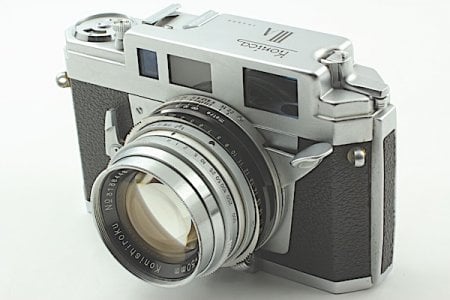
Konica IIIA with 50mm f/1.8 Hexanon lens. Its magnificent 1:1 range/viewfinder has parallax compensating frame lines that also correct for field frame size by narrowing as you focus closer, a feature lacking on Leica Ms and rangefinder Nikons and Canons.
Olympus 35-S-ll (1957) Evolved from the Olmpus 35-S of 1955, the first Japanese 35mm camera with a film wind lever, the Olympus 35-S-ll of 1957 added a 0.6x range/viewfinder with a true projected parallax-comensating bright frameline. It was available with a superb 7-element, 5-group 42mm f/1.8 G. Zuiko normal lens (close to the true diagonal of the 24 x36mm format, which measures just over 43mm) in a Seikosha-SLV 1-1/500 sec plus B shutter and it focuses down to a fairly close 2.8 feet. Its compact form factor is exquisite. If you decide to take the plunge, make sure yours is fitted with the 42mm f/1.8 G. Zuiko or the 42mm f/2 G. Zuiko, a slighty slower variant based on the same formula, and that the shutter is working—they tend to gunk up. Note: this camera was also marketed by Sears under the Tower brand. Used price range: $50-75, slightly higher with “Gold S” logo.
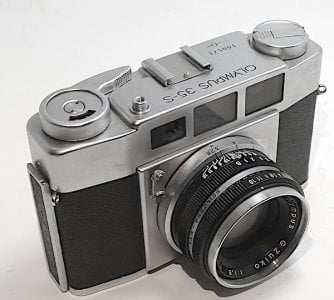
Olympus 35-S II with superb 4.2cm f/1.8 G.Zuiko lens. Its exquisitely proportioned form and superb lens make it a classic, and it's cheap!
Canon P of 1958-1961 was Canon’s last and best attempt to create a broad-spectrum, interchangeable lens, precision rangefinder 35. It was wildly successful—Canon sold twice as many Canon P (for “Populaire”) cameras as any previous model, turning out a total of 87,875 over 2-1/2 years of production. With roots going back to earlier “basic” models like the Canon L2, L3, and IID, it’s essentially a simplified Canon VI-L that uses the same metal-bladed shutter, but in place of Canon’s classic 3-position viewfinder it has a big 1:1 viewfinder that simultaneously displays reflected, etched, parallax compensating frame lines for 35mm, 50mm, and 100mm focal lengths. The parallax compensating pin in the accessory shoe was also eliminated. Everybody loves the Canon P for its simple straightforward design, light weight, and bright 1:1 viewfinder. It’s a great user camera, but it’s not as robustly constructed or finely crafted as a V- or VI-series Canon, its viewfinder tends to flare in backlight, and its simplified viewfinder frame line system cannot compare to the individually selected, true projected frame lines built into 7-series Canons. Current price range for a clean working example with 50mm f/1.8 Canon lens, $250 to $300.
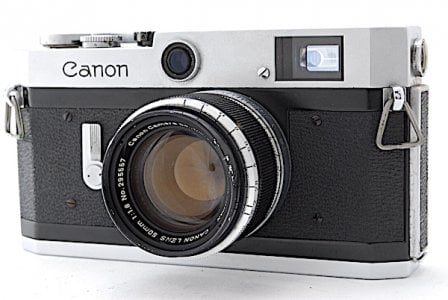
Canon P with 50mm f/1.8 Canon lens. Broad-spectrum model was the best selling screw-mount Canon rangefinder camera of all time
Contax IIa and IIIa: Complete redesigns of the Contax II and III of 1936, the Contax IIa of 1950-61 and IIIa of 1951 to 1961, had a simplified, much more reliable vertical roller blind shutter with nylon straps connecting the curtains and slats made of duraluminum. It’s also smaller, considerably lighter, and has more refined proportions than its illustrious prewar predecessor, albeit resulting in a somewhat shorter rangefinder base length. Along with its less attractive sister the Contax IIIa (which added a klutzy uncoupled selenium meter housing on top) the Contax IIa is functionally the best Contax Zeiss-Ikon ever made, and it’s complemented by a full line of superlative Zeiss bayonet mount lenses. Two variations of the Contax IIa/IIIa were produced: the “black dial” and “color dial” based on the color of the shutter speed numerals. The black dial uses special flash cords for bulb or electronic flash; the “color dial” has a PC outlet and provides X sync at 1/50 sec. Sadly both the Contax IIa and IIIa ceased production in 1960 and were gone by 1961. The Contax IIa is a gorgeous, beautifully proportioned machine with distinctive “cut corner” ends in the Contax rangefinder tradition dating back to the Contax 1 of 1932, It exudes an understated elegance and has an aura of precision that accurately reflects its impressive performance potential in the field. The Contax IIa is a superb user collectible that currently goes for $300-700 in clean to flawless condition with 50mm f/2 or f/1.5 Sonnar lens.
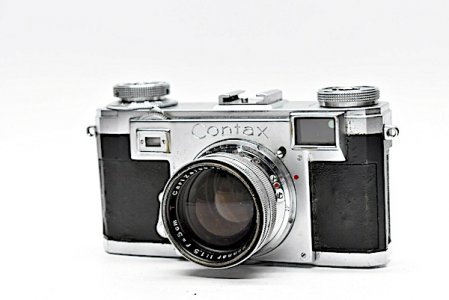
Contax IIa black dial with 50mm f/1.5 Sonnar, a superb and elegant user-collectible with great lens--it's not cheap, but still affrdable
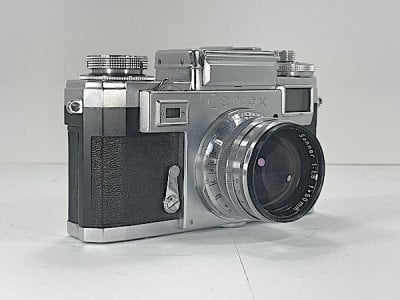
Contax IIIa with 50mm f/1.5 Sonnar--a great camera surmounted with a klutzy uncoupled selenium meter. It's still a superb shooter.
Olympus OM-1 (1973 to 1979) This is the classic ultra-compact 35mm SLR that initiated the compact SLR revolution of the ‘70s and ‘80s. The jewel-like OM-1, first released as the M-1, is a handsome and beautifully made, through-lens-metering, CdS cell, match-needle camera generally said to be the first full-featured, full-frame (24x36mm) modern compact SLR. Designed by a team headed by the esteemed Y. Maitani, its features include a cloth focal-plane shutter with speeds from 1-1/1000 sec plus B, two-CdS cell metering system, fixed pentaprism with interchangeable viewing screens, single-stroke wind lever, mirror lock-up and motor/winder compatibility. Standard lens in OM bayonet mount is a 50mm f/1.4 or f/1.8 Zuiko, and an extensive system of lenses (8mm to 1000mm) and accessories was available. In 1974, Olympus launched the OM-1MD (for Motor Drive), which allowed a motor drive to be attached without modificatiosn. In 1979, the next iteration was the OM-1n, similar to the OM-1MD, but with a redesigned film advance lever, a flash ready/flash OK LED in the viewfinder, and automatic flash sync on X irrespective of the position of the FP/X switch when used with a T-series flash unit on a Flash Shoe 4. All Olympus OM-1 series SLRs are excellent user-collectibles that hold their value well. A pristune original chrome OM-1 (all models) with 50mm f/1.8 or f/1.4 Zuiko lens runs about $125-$225, slightly higher in black. An early one marked M-1 is a collector’s pruze worth $1000 on up. Note: the OM-1’s meter was designed to take discontinued 1.35v mercury batteries and will reqire an uograde ($50-$60) to give accurate readings with current 1.5v alkaline or silver oxide cells.
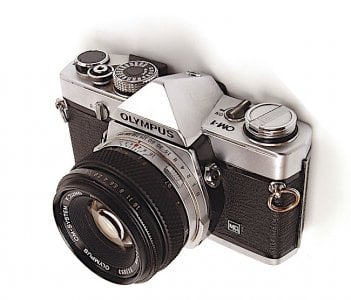
Olympus OM-1 MD had covered motor drive couoling on bottom, MD insignia on front. This ultra-compact beauty needs battery conversion.
Olympus OM-2 (1975-1988i) This aperture-priority-metering automatic-exposure SLR (with full manual operation selected via switch), is based on the earlier, very successful OM-1 form factor with the addition of an ingenious new automatic exposure system—it was the first camera to offer a TTL direct metering system that was dubbed ADM (Auto Dynamic Metering) by Olympus, but is generally known as “off-the-film metering.” The OM-2 also calculated and set the duration and intensity of the flash during the exposure by measuring the amount of light reflected off the film, a system that ensured excellent results under difficult conditions. For non-flash shutter speeds of 1/60s and faster. the twin "silicon blue cell" sensors measured light reflected off a graduated patterned surface on the first shutter curtain shutter. For shutter speeds below 1/60s, the exposure was calculated by the amount of light reflected off the film surface during the exposure. The shutter is a horizontal cloth type providing speeds of 60-1/1000 sec in auto-exposure mode (120s-1/1000sec with the OM-2N), and 1-1/1000 sec, plus B in metered manual mode. The Olympus OM-2 series continued with the OM-2 MD, OM-2N MD and thereafter the heavily revised OM-2S/OM-2 Spot Program, which incorporated entirely new internals mechanism within a similar body. The main difference between the OM-2 and OM-2 MD models was the provision of a removable cap on the base plate to permit attachment of the OM system Motor Drive 1 (or the later Motor Drive 2) for film advance at 5 frames per second and the placement of an "MD" badge on the front left face of the camera. Note: the Olympus OM-2 takes 1.5v silver oxide batteries, which are readily available.
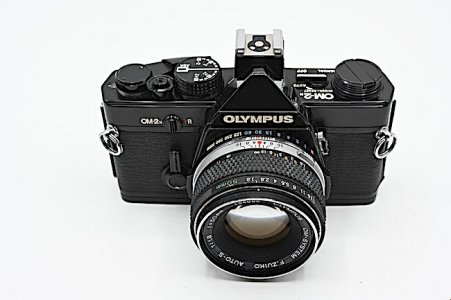
Olympos OM-2n looks spectacular in black, This one sports a 50mm f/1.8 F.Zuiko lens, an excellent classic 6-element, 4-group design.
Canon T90(1986): Developed as the top-of-the-line T-series camera, the T90 is the ultmate manual focus multi-mode SLR with a built-in motor drive and a classic breech-lock FD mount. The form of the pentaprism hump is a distinctive; instead of being sharp-edged as on previous SLRs, it’s rounded with smooth curves. The camera was designed provide an amazing array of seamless automation options and to that end it incorporates a wealth if what was then (and in some ways still is) state-of-the-art technology. The T90 has three metering systems to suit diverse shooting conditions, plus 8 auto-exposure modes and two manual exposure modes that make the camera highly versatile. Drive operations are divided among three small coreless motors to conserve power, and its 7-segnent digital LED viewfinder info display is still unsurpassed, With four size-AA batteries, the built-in motor drive can shoot at a maximum of 4.5 fps. It was truly a top-of-the-line camera, and it is robust and reliable. In Japan, among pros, the camera’s nickname was “The Tank.” You can snag a prstine fully functional Canon T90 with 5omm f/1.8 Canon FD lens for the bargain price of around $150, and about $225 with 50mm f/1.4 lens.
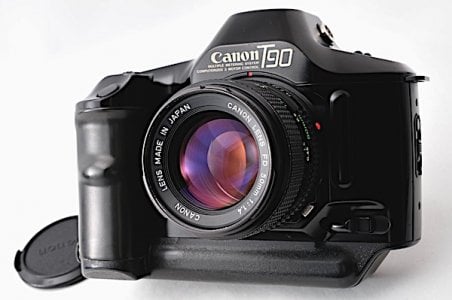
Canon T90 with 50mm f/1.4 Canon FD lens. Note spiel below logo highlighting its high-tech specs. It's a multi-mode masterpiece.
These superb user-collectibles offer real value for users and collectors.
By Jason Schneider
One of my great pasions is shooting pictures on black-and-white film with vintage cameras. Based on my 50+years of doing just that I’ve checked out the prices and formulated value per dollar estimates of some of the best vintage shooters currently posted by camera dealers and on the major online selling sites, and have come up with the list below. It don’t pretend that my list is exhaustive (I’m sure many of you could come up with alternative lists), but it has the advantages of being hearfelt and based on extensive hands-on experience. I hope you enjoy it and find it useful—please let me know.

Original early Nikon F shown with plain prism and later c.1970 50mm f/1.4 Auto Nikkor-S lens. It's a timeless classic and a great shooter.
Nikon F 1959. The legendary Nikon F was the first truly professional caliber SLR, and was conceived as the basis for a high quality professional SLR system. The Nikon F remained in production, with relatively minor changes, for nearly 14 years, and during that time it established Nikon as the leading professional 35mm camera. A handsome, rugged, reliable machine of modular design, its removable pentaprism and external meter-coupling system allowed the Nikon F to be retrofitted with the latest advances in metering technology by upgrading the meter prism, and its F mount has endured, with some operational changes, up to the present digital era—a remarkable example of non-obsolescence. While the Nikon F is not really a technological landmark it marked the coming of age of the 35mm SLR. Its features include: Titanium foil focal-plane shutter (early models had cloth shutters) with speeds from 1-1/1000 sec plus B and T, interchangeable finders and screens, and a removable back. An extensive range of lenses and specialized accessories is available. The Nikon F is a superb user-collectible, and these days you can snag a clean functional example in chrome with FT or FTn meter prism and 50mm f/1.4 Nikkor-S lens for only $150 to $250. A pristine early (1959 to 1962) Nikon F with non-TTL “flag type” meter prism and original 5.8cm f/1.4 Nikkor lens typically runs about $800-1000; and very early models with cloth shutter, and not modified to take the later meter prisms are rarer and even pricier.

Nikon F2 Photomic with DP-1 prism and 55mm f/3.5 Micro-Nikkor. lens. Many experts say it was the finest all mechanical manual focus Nikon.
Nikon F2 (1971 to 1980). Widely regarded as the best all metal, fully. mechanically controlled manual focus 35mm SLR Nikon ever made, the Nikon F2 has a horizontal travel, titanium foil focal plane shutter with speeds of 1-1/2000 sec plus B and T, stepless intermediate speed settings possible from 1/80 to 1/2000 sec, and slow speeds of 2 to 10 sec available via the B setting by using the self-timer. It also has a more convenient hinged, detachable back, and a more secure prism mounting system. The F2 Photomic with DP-1 prism finder privides TTL center-weighted, center-the-needle readings at full aperture plus stopdown metering and uses CdS cells powered by two 1.5v silver-oxide batteries. The Nikon F2S with DP-2 prism finder employs improved CdS cells, reads out the exposure using 2 signal lights in place of a needle, has a top-mounted flash ready light, and a contact for an EE aperture control unit. The Nikon F2SB uses two memory-lag-free SBC meter cells, reads out via a 3-LED display with 5 exposure gradations, is cross coupled to both aoerture and shutter speed controls, and displays cirrect exposure in a top panel when the eyepiece blnd is closed. The Nikon F2A and F2AS have Nikon DP-11 and DP-12 meter prisms respectovely, both of which work with later Nikkor lenses that privde auto maximum aperture indexing. The Nikon F2AS is the last and best of the line, with SBC cells, LED readouts, and the ability to read diwn to -4EV at ISO 100 with the f/1.4 lens. Current price ranges for very clean fully functional Nikon F2s in chrome or black: with plain prism, $250-300, Nikon F2A with DP-11 prism, $300-$350, F2AS with 50mm f/1.4, $350-$450, Nikonn F2T (Titanium), $1,200-$1,500, body only or with 50mm f/2 Nikkor.

Nikon F2 AS, acclaimed as the last and best of the line. It had a very sensitive SBC cell meter prism and brilliant segmented LED readouts.
Topcon RE Super (1963) Sold in the U.S. as the Beseler Topcon Super D it was the first 35mm SLR with through-the-lens match-needle metering, manufactured by Tokyo Optical Company, Ltd. and initiated the basic trend that all other SLR makers were destined to follow. The RE Super was unique in having its CdS meter cell built into the mirror, permitting the use of simple interchangeable optical finders, but this system, designed in a joint project with Toshiba Electric Co., proved complex and expensive to produce. The RE was eclipsed one year later by the Pentax Spotmatic, which took TTL readings off the viewing screen, a simpler system adopted by virtually every other maker. Large, robust, and nicely finished, the Topcon RE Super features include; Interchangeable eye-level pentaprism and finder screens, single-stroke wind lever, full-aperture metering, cloth focal-plane shutter with speeds from 1-1/1000 sec plus B, winder/motor compatibility, and Exakta-compatible bayonet mount. Standard lens is the magnificecent 58mm f/1.4 R.E. Auto Topcor. The RE Super was produced in four versions and provided the basis for the Topcon D-1 and Super DM that remained in production until the ‘80s. A clean original Topcon or Beseler Topcon RE Super or Super D in chrome with 58mm f/1.4 lens sells for around $350-$500, but is more commonly paired with the outstsanding 58mm f/1.8 Topcor, a combo that typically fetches $200-$275.00. Note: these cameras were deigned to use out of production 1.35v mercuric oxide batteries and must be converted to meter properly with current 1.5v akaline or silver oxide cells.

Beseler Topcon Suoer D with outstanding 5.8cm f/1.8 R.E. Auto-Topcor lens. The 5.8cm f/1.4 R.E. Auto-Topcor is legendary, but this combo typically costs a lot less.

Beseler Topcon Super D with superlative 5.8cm f/1.4 R.E. Auto-Topcor lens noted for its amazing combination of sharpness, gorgeous rendition, add lovely natural bokeh.
Mamiyaflex C (1956) The first of the Mamiyaflex C-series, the only interchangeable-lens, 6x6cm (2-1/4 square) twin-lens reflex cameras that were a real commercial success, it established the basic design. All feature removable lens sets, consisting of taking and viewing lenses attached to an abbreviated lensboard.. Like all C-series Mamiyaflexes, the original C is a rugged, durable, professional caliber camera with rack-and-pinion knob focusing and a bellows behind the lensboard. It also features knob wind (changed to a crank on later models) waist-level viewing (eye-level mirror prisms were later offered) and an outstanding 5-element, 3-group 80mm f/2.8 Mamiya-Sekor normal lens in a Seikosha-MX 1-1/400 sec shutter. Alternative focal-length lens sets included 65mm 105mm 135mm and 180mm—later, a 55mm and 250mm. The last of the breed, the Mamiya C330S, was discontinued in 1993. The Mamiyaflex C and the nearly identical C2 lack double exposure prevemtion, and only have parallax indication, not correction like postwar Rolleiflex TLRs, but they’re fine-performing user cameras. Note: those with lenses incorporporating the Seikosha-MX 1-1/400 sec shutter have 11-bladed diaphragms resulting in smoother bokeh; later lenses, like all postwar Rolleiflex TLRs, have 5-bladed diaphragms. Clean fully working examples of the Mamiyaflex C and C2 with 80mm or 105mm lens set currently go for an enticing $125 to $225.

Mamiyaflex C orginal 1956 model with distinctive pointy "feet" on base, amd 10.5cm f/3.5 lens set. Early lenses in Sekosha MX shutters have 11-bladed diaphragms.

Mamiyaflex C2 with flat bottom, dual focusing knobs , and later 80mm f/2.8 Mamiya-Sekor lens with 1/500 sec Seiko shutter.
Ricoh Diacord G: Introduced in 1958 to compete with the immensely popular Yashica-Mat, this unsung classic performs just as well, albeit with a film wind knob intead of a film wind crank. Its signature feature is a “see-saw” double-ended focusing lever that provides efficient “two finger” manual focusing down to a marked 3.5 feet (it actually gets diwn to about 3 feet) and its reflex finder is bright and crisp. The viewing lens is a 3-element, 3-group 80mm f/3.5 Ricoh Viewer and the taking lens is an excellent 80mm f/3.5 Rikenon, a 4-element, 3-group Tessar design that stops down to f/22 (even though the manual says f/16.) Both lenses are fitted with bayonet flanges and accept Series 1 Rolleinar close-up sets. The shutter is a Citizen MV or MXV both prividing speeds of 1-1/400 sec plus B. Note: This camera was available with a few different nameplates, not all of which say Diacord (a contraction denoting Diamond top-level series and Cord taken from Rolleicord). Some are fitted with 3-element Riconar taking lenses, so make sure the one you acquire has the superior 80mm f/3.5 Rikenon. Long neglected, these cameras have lately attracted a small but devoted following, resulting in higher prices. Current price range for a pristine example wigth cap and case: $135-$200. Note: The later Rcoh Diacord L is basically the same camera with a built-in uncoupled meter with a side-munted readout index and a selenium cell with cover above the viewing lens. It’s a very good camera, but not as elegant as the meterless Diacird G and it sells for up to $250 or so.

Ricoh Diacord G with 80mm f/3.5 Rikenon taking lens in Citizen MV 1/1/400 sec plus B shutter. Note "see-saw" two finger focusing levers.

Ricoh Diacord L with built-in selenium meter, Seikosha MXL 1-1/500 sec plus B shutter. It's not as elegant as the Ricoh Diacord G, and pricier.
Konica IIIA (1958) Perhaps the finest, most advanced example of the meterless, leaf shutter Japanese rangefinder 35 that flourished in the ‘50s, the beautifully made, elegantly proportioned Konica IIIA featured an unusual, vertically-mounted, left-handed, rapid-wind lever (an acquired taste), and a gorgeous 1:1 range/viewfinder with true projected, parallax-compensating finder framelines that also adjust for field frame size (that is, reduced angular coverage as you focus closer). Other features include: An excellent 50mm f/1.8 or f/2 Hexanon lens, Seikosha 1-1/500 sec MX shutter, rewind crank and self timer. Both lenses are superb, but the smaller 50mm f/2 looks nicer on the camera, and the larger diameter 50mm f/1.8 is allegedly a tad sharper. Konica IIIAs in pristine condition are fine user-collectibles that currently fetch prices in the $150-250 range.

Konica IIIA with 50mm f/1.8 Hexanon lens. Its magnificent 1:1 range/viewfinder has parallax compensating frame lines that also correct for field frame size by narrowing as you focus closer, a feature lacking on Leica Ms and rangefinder Nikons and Canons.
Olympus 35-S-ll (1957) Evolved from the Olmpus 35-S of 1955, the first Japanese 35mm camera with a film wind lever, the Olympus 35-S-ll of 1957 added a 0.6x range/viewfinder with a true projected parallax-comensating bright frameline. It was available with a superb 7-element, 5-group 42mm f/1.8 G. Zuiko normal lens (close to the true diagonal of the 24 x36mm format, which measures just over 43mm) in a Seikosha-SLV 1-1/500 sec plus B shutter and it focuses down to a fairly close 2.8 feet. Its compact form factor is exquisite. If you decide to take the plunge, make sure yours is fitted with the 42mm f/1.8 G. Zuiko or the 42mm f/2 G. Zuiko, a slighty slower variant based on the same formula, and that the shutter is working—they tend to gunk up. Note: this camera was also marketed by Sears under the Tower brand. Used price range: $50-75, slightly higher with “Gold S” logo.

Olympus 35-S II with superb 4.2cm f/1.8 G.Zuiko lens. Its exquisitely proportioned form and superb lens make it a classic, and it's cheap!
Canon P of 1958-1961 was Canon’s last and best attempt to create a broad-spectrum, interchangeable lens, precision rangefinder 35. It was wildly successful—Canon sold twice as many Canon P (for “Populaire”) cameras as any previous model, turning out a total of 87,875 over 2-1/2 years of production. With roots going back to earlier “basic” models like the Canon L2, L3, and IID, it’s essentially a simplified Canon VI-L that uses the same metal-bladed shutter, but in place of Canon’s classic 3-position viewfinder it has a big 1:1 viewfinder that simultaneously displays reflected, etched, parallax compensating frame lines for 35mm, 50mm, and 100mm focal lengths. The parallax compensating pin in the accessory shoe was also eliminated. Everybody loves the Canon P for its simple straightforward design, light weight, and bright 1:1 viewfinder. It’s a great user camera, but it’s not as robustly constructed or finely crafted as a V- or VI-series Canon, its viewfinder tends to flare in backlight, and its simplified viewfinder frame line system cannot compare to the individually selected, true projected frame lines built into 7-series Canons. Current price range for a clean working example with 50mm f/1.8 Canon lens, $250 to $300.

Canon P with 50mm f/1.8 Canon lens. Broad-spectrum model was the best selling screw-mount Canon rangefinder camera of all time
Contax IIa and IIIa: Complete redesigns of the Contax II and III of 1936, the Contax IIa of 1950-61 and IIIa of 1951 to 1961, had a simplified, much more reliable vertical roller blind shutter with nylon straps connecting the curtains and slats made of duraluminum. It’s also smaller, considerably lighter, and has more refined proportions than its illustrious prewar predecessor, albeit resulting in a somewhat shorter rangefinder base length. Along with its less attractive sister the Contax IIIa (which added a klutzy uncoupled selenium meter housing on top) the Contax IIa is functionally the best Contax Zeiss-Ikon ever made, and it’s complemented by a full line of superlative Zeiss bayonet mount lenses. Two variations of the Contax IIa/IIIa were produced: the “black dial” and “color dial” based on the color of the shutter speed numerals. The black dial uses special flash cords for bulb or electronic flash; the “color dial” has a PC outlet and provides X sync at 1/50 sec. Sadly both the Contax IIa and IIIa ceased production in 1960 and were gone by 1961. The Contax IIa is a gorgeous, beautifully proportioned machine with distinctive “cut corner” ends in the Contax rangefinder tradition dating back to the Contax 1 of 1932, It exudes an understated elegance and has an aura of precision that accurately reflects its impressive performance potential in the field. The Contax IIa is a superb user collectible that currently goes for $300-700 in clean to flawless condition with 50mm f/2 or f/1.5 Sonnar lens.

Contax IIa black dial with 50mm f/1.5 Sonnar, a superb and elegant user-collectible with great lens--it's not cheap, but still affrdable

Contax IIIa with 50mm f/1.5 Sonnar--a great camera surmounted with a klutzy uncoupled selenium meter. It's still a superb shooter.
Olympus OM-1 (1973 to 1979) This is the classic ultra-compact 35mm SLR that initiated the compact SLR revolution of the ‘70s and ‘80s. The jewel-like OM-1, first released as the M-1, is a handsome and beautifully made, through-lens-metering, CdS cell, match-needle camera generally said to be the first full-featured, full-frame (24x36mm) modern compact SLR. Designed by a team headed by the esteemed Y. Maitani, its features include a cloth focal-plane shutter with speeds from 1-1/1000 sec plus B, two-CdS cell metering system, fixed pentaprism with interchangeable viewing screens, single-stroke wind lever, mirror lock-up and motor/winder compatibility. Standard lens in OM bayonet mount is a 50mm f/1.4 or f/1.8 Zuiko, and an extensive system of lenses (8mm to 1000mm) and accessories was available. In 1974, Olympus launched the OM-1MD (for Motor Drive), which allowed a motor drive to be attached without modificatiosn. In 1979, the next iteration was the OM-1n, similar to the OM-1MD, but with a redesigned film advance lever, a flash ready/flash OK LED in the viewfinder, and automatic flash sync on X irrespective of the position of the FP/X switch when used with a T-series flash unit on a Flash Shoe 4. All Olympus OM-1 series SLRs are excellent user-collectibles that hold their value well. A pristune original chrome OM-1 (all models) with 50mm f/1.8 or f/1.4 Zuiko lens runs about $125-$225, slightly higher in black. An early one marked M-1 is a collector’s pruze worth $1000 on up. Note: the OM-1’s meter was designed to take discontinued 1.35v mercury batteries and will reqire an uograde ($50-$60) to give accurate readings with current 1.5v alkaline or silver oxide cells.

Olympus OM-1 MD had covered motor drive couoling on bottom, MD insignia on front. This ultra-compact beauty needs battery conversion.
Olympus OM-2 (1975-1988i) This aperture-priority-metering automatic-exposure SLR (with full manual operation selected via switch), is based on the earlier, very successful OM-1 form factor with the addition of an ingenious new automatic exposure system—it was the first camera to offer a TTL direct metering system that was dubbed ADM (Auto Dynamic Metering) by Olympus, but is generally known as “off-the-film metering.” The OM-2 also calculated and set the duration and intensity of the flash during the exposure by measuring the amount of light reflected off the film, a system that ensured excellent results under difficult conditions. For non-flash shutter speeds of 1/60s and faster. the twin "silicon blue cell" sensors measured light reflected off a graduated patterned surface on the first shutter curtain shutter. For shutter speeds below 1/60s, the exposure was calculated by the amount of light reflected off the film surface during the exposure. The shutter is a horizontal cloth type providing speeds of 60-1/1000 sec in auto-exposure mode (120s-1/1000sec with the OM-2N), and 1-1/1000 sec, plus B in metered manual mode. The Olympus OM-2 series continued with the OM-2 MD, OM-2N MD and thereafter the heavily revised OM-2S/OM-2 Spot Program, which incorporated entirely new internals mechanism within a similar body. The main difference between the OM-2 and OM-2 MD models was the provision of a removable cap on the base plate to permit attachment of the OM system Motor Drive 1 (or the later Motor Drive 2) for film advance at 5 frames per second and the placement of an "MD" badge on the front left face of the camera. Note: the Olympus OM-2 takes 1.5v silver oxide batteries, which are readily available.

Olympos OM-2n looks spectacular in black, This one sports a 50mm f/1.8 F.Zuiko lens, an excellent classic 6-element, 4-group design.
Canon T90(1986): Developed as the top-of-the-line T-series camera, the T90 is the ultmate manual focus multi-mode SLR with a built-in motor drive and a classic breech-lock FD mount. The form of the pentaprism hump is a distinctive; instead of being sharp-edged as on previous SLRs, it’s rounded with smooth curves. The camera was designed provide an amazing array of seamless automation options and to that end it incorporates a wealth if what was then (and in some ways still is) state-of-the-art technology. The T90 has three metering systems to suit diverse shooting conditions, plus 8 auto-exposure modes and two manual exposure modes that make the camera highly versatile. Drive operations are divided among three small coreless motors to conserve power, and its 7-segnent digital LED viewfinder info display is still unsurpassed, With four size-AA batteries, the built-in motor drive can shoot at a maximum of 4.5 fps. It was truly a top-of-the-line camera, and it is robust and reliable. In Japan, among pros, the camera’s nickname was “The Tank.” You can snag a prstine fully functional Canon T90 with 5omm f/1.8 Canon FD lens for the bargain price of around $150, and about $225 with 50mm f/1.4 lens.

Canon T90 with 50mm f/1.4 Canon FD lens. Note spiel below logo highlighting its high-tech specs. It's a multi-mode masterpiece.
| |
| |
| |
| |
| |
|
Attachments
Last edited:
Mos6502
Well-known
My personal faves for great values in vintage cameras would be Exakta's VXIIb, VX1000, and VX500. Or any of the sector shutter Exa range (the focal plane Exas regrettably are hugely unreliable). Unfortunately the Exakta VXIIa was made over a period when the company was sourcing shutter curtain materials that have aged very badly, so as beautiful as those cameras are they're a big risk to buy unless you can inspect and test one in person. On the other hand the last three models of Exakta, although not as pretty (nor as well finished IMO), are generally more robust. I've had a number of them which after brushing out the dust and putting a few drops of oil in the right spots, the shutter speeds came back, as nears as spot on for a camera of this age, as I've seen with any vintage camera I've repaired. No adjustment in spring tension needed! Pretty remarkable. However, the real appeal of these cameras is the wide range of weird and wonderful lenses that were available. I've shot quite a few rolls through an Exa with a Schneider Xenon mounted, and that Schneider lens is really as good as anything anybody else was making in the 1950s. Indeed quite a bit better than most 50s made years later.
Another camera I'd pitch is the Olympus Ace. A neat little RF with a leaf shutter and interchangeable lenses. The camera and the standard lens can be found for little money, although finding the accessory lenses could get a little pricey (I have not attempted to find a whole set).
I agree the Diacord is oft overlooked by those looking for a TLR. I suppose one could criticize it for being not quite as sharp as the better Minoltas and Mamiyas, but unless you're printing 16" images, who really is going to know? The common (and cheap) Ricohflex is also a great entry point to medium format, alas most of them suffer from petrified grease and thus stuck focus these days.
Another camera I'd pitch is the Olympus Ace. A neat little RF with a leaf shutter and interchangeable lenses. The camera and the standard lens can be found for little money, although finding the accessory lenses could get a little pricey (I have not attempted to find a whole set).
I agree the Diacord is oft overlooked by those looking for a TLR. I suppose one could criticize it for being not quite as sharp as the better Minoltas and Mamiyas, but unless you're printing 16" images, who really is going to know? The common (and cheap) Ricohflex is also a great entry point to medium format, alas most of them suffer from petrified grease and thus stuck focus these days.
Looks like a Nikon F "Apollo" with Plastic Tip and steel inserts for the strap lugs. I have a pair of those, and a pair of early Nikon F2 bodies with all-metal advance levers and no steel inserts for the strap lugs. Picked up 20+ years ago? I've been given Five Nikon F's in the last couple of years. People at work would just give me their old gear. Two of the Nikon F bodies are "Mirror-up Modified", Questar I think. 20 years ago I was using a Nikon F at the Playground to take pictures of my Daughter. Another Dad told me "Still living in the Stone-age, Huh?" He had a DSLR. Told him one EMP and all of his pictures were gone. Then he told me the electronics in mine would stop working. I just laughed.
wlewisiii
Just another hotel clerk
I had a T90 with a 50/1.4SC old breech mound. Damn, that was a sweet camera.
These days though I ponder a Nikon F with plain prism (I disliked the Photomic finder on an F2 I used to have so...) since I have a good handheld meter anyway and lots of nice Nikkor glass
Never cottoned to the OM1 when I tried it. Same problem with my Nikkormat - don't care for the controls around the lens.
Thanks for yet another fun article.
These days though I ponder a Nikon F with plain prism (I disliked the Photomic finder on an F2 I used to have so...) since I have a good handheld meter anyway and lots of nice Nikkor glass
Never cottoned to the OM1 when I tried it. Same problem with my Nikkormat - don't care for the controls around the lens.
Thanks for yet another fun article.
Tim Murphy
Well-known
Dear Board,
I have the Nikon FTN, and F2, a couple of Nikkormats in FTN and FT2 configurations, a Topcon Super DM and RE Super along with the Canon T90 and an Olympus OM-10 with the manual adapter, which is essentially an OM-1 with a built in hot shoe.
I also have a couple of Spotmatic F's with a collection of SMC Takumars that allow full aperture metering. They were the bargains of the bunch, even the lenses were cheap. And they gave me full aperture metering, which to my old squinty eyes is a deal maker!
Regards,
Tim Murphy
Harrisburg PA
I have the Nikon FTN, and F2, a couple of Nikkormats in FTN and FT2 configurations, a Topcon Super DM and RE Super along with the Canon T90 and an Olympus OM-10 with the manual adapter, which is essentially an OM-1 with a built in hot shoe.
I also have a couple of Spotmatic F's with a collection of SMC Takumars that allow full aperture metering. They were the bargains of the bunch, even the lenses were cheap. And they gave me full aperture metering, which to my old squinty eyes is a deal maker!
Regards,
Tim Murphy
Harrisburg PA
wlewisiii
Just another hotel clerk
That post reminds me ... My only current Pentax is a Honeywell H1a (an early meter-less SLR with officially only 1/500th though a spot for 1/1000 on the dial exists even if it isn't marked and is rarely fully accurate...  ) I have a Super Takumar 50/1.4, 55/2 & a Vivtar 135/2.8 in hand, a Super Takumar 28/3.5 on the way from Chris Crawford and the only other lens I plan to get for it is a TT Artisan 100/2.8 "Soap Bubble" Triotar. That will be a perfect kit for my tastes.
) I have a Super Takumar 50/1.4, 55/2 & a Vivtar 135/2.8 in hand, a Super Takumar 28/3.5 on the way from Chris Crawford and the only other lens I plan to get for it is a TT Artisan 100/2.8 "Soap Bubble" Triotar. That will be a perfect kit for my tastes.
I've considered getting a Spotmatic F quite often, but every-time I come close, something else is more important. Probably next payday will be an Amedo Nikon S to M adapter being more important
I've considered getting a Spotmatic F quite often, but every-time I come close, something else is more important. Probably next payday will be an Amedo Nikon S to M adapter being more important
Jason Schneider
the Camera Collector
The Pentax Spotmatic F is one of my favorite Pentaxes and it’s a great camera (especially with the excellent 50mm f/1.4 Takumar).I regret selling mine since I have a passel of M-42 lenses by Zeiss DDR.
Jason Schneider
the Camera Collector
Electronics in cameras can do some wonderful things, even in analog cameras, but when they go south, replacement parts may no longer be available other than by cannibalization. In contrast ancient mechanical cameras can usually be repaired by fabricating replacement parts if need be. The other problem is batteries. If they go out of production it may not be possible to jury rig a replacement power source. If you’re a user collector make sure it’s powered by batteries that are unlikely to go out of production anytime soon, like (heaven forefend) AAs!Looks like a Nikon F "Apollo" with Plastic Tip and steel inserts for the strap lugs. I have a pair of those, and a pair of early Nikon F2 bodies with all-metal advance levers and no steel inserts for the strap lugs. Picked up 20+ years ago? I've been given Five Nikon F's in the last couple of years. People at work would just give me their old gear. Two of the Nikon F bodies are "Mirror-up Modified", Questar I think. 20 years ago I was using a Nikon F at the Playground to take pictures of my Daughter. Another Dad told me "Still living in the Stone-age, Huh?" He had a DSLR. Told him one EMP and all of his pictures were gone. Then he told me the electronics in mine would stop working. I just laughed.
wlewisiii
Just another hotel clerk
That's one thing I truly love about my Nikon F4.Electronics in cameras can do some wonderful things, even in analog cameras, but when they go south, replacement parts may no longer be available other than by cannibalization. In contrast ancient mechanical cameras can usually be repaired by fabricating replacement parts if need be. The other problem is batteries. If they go out of production it may not be possible to jury rig a replacement power source. If you’re a user collector make sure it’s powered by batteries that are unlikely to go out of production anytime soon, like (heaven forefend) AAs!
Jason Schneider
the Camera Collector
I like Exaktas, maybe because their weird personalities reminds me of my own. I own 22 of them and use them with satisfaction, but I didn’t include them in this article because, as you note, so many of them have duff shutter curtains which renders them unrepairable at a cost commensurate with their value. In general prewar, early postwar, and late models don’t have this affliction, but that leaves a vast number of cameras in the middle and I know of no serial number list that is dispositive in this regard. Also, based on my experience I would not effusively praise the 50mm Schneider Xenon, which I would call very good but not spectacular. My favotite normal lens for the Exakta is the 55mm f/1.9 Steinheil Quinon, and I believe the Pancolar (late DDR) will certainly give the Xenon a run for the money.My personal faves for great values in vintage cameras would be Exakta's VXIIb, VX1000, and VX500. Or any of the sector shutter Exa range (the focal plane Exas regrettably are hugely unreliable). Unfortunately the Exakta VXIIa was made over a period when the company was sourcing shutter curtain materials that have aged very badly, so as beautiful as those cameras are they're a big risk to buy unless you can inspect and test one in person. On the other hand the last three models of Exakta, although not as pretty (nor as well finished IMO), are generally more robust. I've had a number of them which after brushing out the dust and putting a few drops of oil in the right spots, the shutter speeds came back, as nears as spot on for a camera of this age, as I've seen with any vintage camera I've repaired. No adjustment in spring tension needed! Pretty remarkable. However, the real appeal of these cameras is the wide range of weird and wonderful lenses that were available. I've shot quite a few rolls through an Exa with a Schneider Xenon mounted, and that Schneider lens is really as good as anything anybody else was making in the 1950s. Indeed quite a bit better than most 50s made years later.
Another camera I'd pitch is the Olympus Ace. A neat little RF with a leaf shutter and interchangeable lenses. The camera and the standard lens can be found for little money, although finding the accessory lenses could get a little pricey (I have not attempted to find a whole set).
I agree the Diacord is oft overlooked by those looking for a TLR. I suppose one could criticize it for being not quite as sharp as the better Minoltas and Mamiyas, but unless you're printing 16" images, who really is going to know? The common (and cheap) Ricohflex is also a great entry point to medium format, alas most of them suffer from petrified grease and thus stuck focus these days.
wlewisiii
Just another hotel clerk
Closest I'll get to an Exacta is the 50/3.5 Exacta red "T" Tessar put into a Contax 1.5 shell and then adjusted to Nikon S standard by Brian 
Sweet & terribly cute lens
Sweet & terribly cute lens
S.H.
Picture taker
The Topcon is a nice one, my Nikon F feels a bit rough compared to it. It has an Exakta mount and can easily use quite a few fun lenses (in manual stop down mode), for example the Biotar 75 1.5 or a Sonnar 180 2.8. That is precisely why I have one (not used it yet, really must find the time).
I'd like to find an early Biotar 5.8cm for it too.
I'd like to find an early Biotar 5.8cm for it too.
Mos6502
Well-known
While the Pancolar is very good indeed (and because it was the kit lens for so many years, easy to find and inexpensive compared to the Xenon) the Schneider Xenon is (or at least my example is) perfectly sharp in the center at f/1.9, a feat the Pancolar cannot match. Stopping down barely improves sharpness on the Xenon, although, against it, the corners remain soft until well stopped down (testing it against six other 50mm lenses in my collection the Xenon was sharper in the center than any others, but corner sharpness was worse than most, even the lowly Mamiya 2/50 was sharper all the way down to f/5.6). However, aside from optics, I just prefer the ergonomics of the Xenon over the Pancolar. As my Xenon is an early version of the automatic it also has 20 diaphragm blades. Now if the comparison were between the later compact Xenon and the Pancolar, I might favor the Pancolar a bit more overall.I would not effusively praise the 50mm Schneider Xenon, which I would call very good but not spectacular. My favorite normal lens for the Exakta is the 55mm f/1.9 Steinheil Quinon, and I believe the Pancolar (late DDR) will certainly give the Xenon a run for the money
Speaking of Mamiya, The Mamiya 500/1000 DTL is really an underappreciated gem. I've had three, all beat to hell, all worked perfectly, even the meters! I don't think I ever paid more than $20 for one. Sure, the fit and finish is not Pentax grade, but they're rugged and apparently nearly indestructable. A great alternative to the Spotmatic. Totally forgot I still had one packed away until last weekend when I surprised myself by pulling it out of a box in the back of the closet. And yes it still worked, meter and all.
Jason Schneider
the Camera Collector
The 75mm f/1.5 Biotar is a unique and wonderful lens but it costs the earth. Also one of the greatest assets the Topcon Super D system is the superb lenses made by Tokyo Optical Co. almost all of which are outstanding. The two 5.8cm R.E. Auto-Topcors are both sharper than the 5.8xm f/2 Biotar and have oodles of “character,” but all vintage lenses have unique rendition so by all means have at it. Good shooting!
DownUnder
Nikon Nomad
The Nikkormat. Any Nikkormat model. Indestructible. Made from cast iron and held together with ocean liner rivets.
Mine have been with me to North America (two times), around Australia (three times), and in Southeast Asia (more times than I have fingers and toes to count my trips on). Always produced the goods.
F lenses fit them perfectly. Especially the old 1960s ones, which nobody seems to want to collect and few use. Dirt cheap, or used to be.
I can even use my more recent Nikon D series lenses (like the 24 and the 20, both unaffordable even in 'F' mounts) if I remember to stop down the aperture with a finger and adjust the exposure accordingly. Yes, slow going, but I do mostly architecture photography, so my subjects never get up and walk away...
My two FT2s have kept going with very minimal servicing - IRRC I've only had to replace the felts, and this only once in almost 40 years. Both still meter quite accurately but nowadays I no longer bother with batteries, a clip-on Voigtlander meter I found years ago for chips money in a charity shop, does it all for me.
An FTN or FT2 with the legendary Nikkor 50/2.0 is a complete kit for almost everything. One of my two FT2s has this lens, dating to 1970. The other wears a 35/2.0 I acquired for peanuts from a newspaper discarded photo gear sale in the 1990s.
Nikkormats - the best investment I've ever made in all my cameras.
Mine have been with me to North America (two times), around Australia (three times), and in Southeast Asia (more times than I have fingers and toes to count my trips on). Always produced the goods.
F lenses fit them perfectly. Especially the old 1960s ones, which nobody seems to want to collect and few use. Dirt cheap, or used to be.
I can even use my more recent Nikon D series lenses (like the 24 and the 20, both unaffordable even in 'F' mounts) if I remember to stop down the aperture with a finger and adjust the exposure accordingly. Yes, slow going, but I do mostly architecture photography, so my subjects never get up and walk away...
My two FT2s have kept going with very minimal servicing - IRRC I've only had to replace the felts, and this only once in almost 40 years. Both still meter quite accurately but nowadays I no longer bother with batteries, a clip-on Voigtlander meter I found years ago for chips money in a charity shop, does it all for me.
An FTN or FT2 with the legendary Nikkor 50/2.0 is a complete kit for almost everything. One of my two FT2s has this lens, dating to 1970. The other wears a 35/2.0 I acquired for peanuts from a newspaper discarded photo gear sale in the 1990s.
Nikkormats - the best investment I've ever made in all my cameras.
CMur12
Well-known
Thanks for another great article, Jason. They're truly a unique contribution to this forum.
The Nikon F, F2, and Nikkormat FTn were all current when I first became seriously involved in photography. They were entirely out of my reach then, as a university student with limited discretionary cash, but I still remember them wistfully. I had a Nikon F for awhile, and I recently bought a Nikkormat from a fellow RFF member.
For 35mm, I'm really a longtime Minolta user. I especially like the SR-T 102 (in particular, the ones that have mirror lock-up) and my favorite electronic model is the X-570. The X-570 is very light and compact with a normal lens, but add the Autowinder G and it balances well with my hefty 85mm 1.7 lens. I watched the development of autofocus SLRs with mild interest, but I never bought into it.
- Murray
The Nikon F, F2, and Nikkormat FTn were all current when I first became seriously involved in photography. They were entirely out of my reach then, as a university student with limited discretionary cash, but I still remember them wistfully. I had a Nikon F for awhile, and I recently bought a Nikkormat from a fellow RFF member.
For 35mm, I'm really a longtime Minolta user. I especially like the SR-T 102 (in particular, the ones that have mirror lock-up) and my favorite electronic model is the X-570. The X-570 is very light and compact with a normal lens, but add the Autowinder G and it balances well with my hefty 85mm 1.7 lens. I watched the development of autofocus SLRs with mild interest, but I never bought into it.
- Murray
S.H.
Picture taker
My early post war olympic sonnar 18cm in exakta removable mount: the rear fully unscrews to reveal what looks like a flektoskop (or flektometer?) Contax mirror box mount. Heavy metal, rotatable tripod collar... A beast.The Topcon is a nice one, my Nikon F feels a bit rough compared to it. It has an Exakta mount and can easily use quite a few fun lenses (in manual stop down mode), for example the Biotar 75 1.5 or a Sonnar 180 2.8. That is precisely why I have one (not used it yet, really must find the time).
I'd like to find an early Biotar 5.8cm for it too.
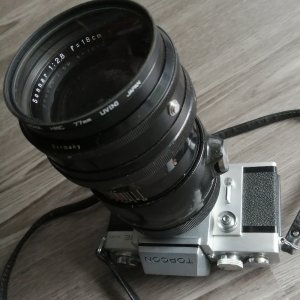
When this lens was new I don't think the exakta prism existed. Good luck holding this with a wlf
I have a 30cm of the same vintage, late 40s. Huge.
das
Well-known
If collecting were also not a requirement, here are my two cents in 2024 for some of the better values in performance/price/coolness:
1. Nikon F4 & Nikon F80/N80. They are GIVING AWAY F80s these days. Like $50 or less cheap.
2. Any of the better late 1990s and after Canon EOS mid-range and high-range autofocus cameras.
3. Chinon CE-3 for M42 lenses. The Swiss army knife for the M42 world.
4. Contax RX, Contax RTS II & Contax ST. Everyone wants a 139Q or 167MT these days for whatever reason. I don't understand it. For the same price, you can get a much, much nicer Contax body.
5. I agree on the Konica IIIs (would opt for a IIIA or IIIM). The IIA has the same lens and is cheap and wonderful.
6. Konica FT-1 for AR lenses.
7. Yashica FX-D or FX-103. People are giving these cameras away for nothing. Essentially, free 139Qs.
I am generally not a fan of any of the standard 70/80s line of prosumer manual focus cameras from Nikon, Canon, Olympus, Minolta, Pentax, etc. For me, it's not worth the $$$ to build a decent system from scratch, where you could just save all that money and go right for Contax. For me, unless you already have one, Leica R is a non-starter as cinema folks have driven the lens prices into the stratosphere.
1. Nikon F4 & Nikon F80/N80. They are GIVING AWAY F80s these days. Like $50 or less cheap.
2. Any of the better late 1990s and after Canon EOS mid-range and high-range autofocus cameras.
3. Chinon CE-3 for M42 lenses. The Swiss army knife for the M42 world.
4. Contax RX, Contax RTS II & Contax ST. Everyone wants a 139Q or 167MT these days for whatever reason. I don't understand it. For the same price, you can get a much, much nicer Contax body.
5. I agree on the Konica IIIs (would opt for a IIIA or IIIM). The IIA has the same lens and is cheap and wonderful.
6. Konica FT-1 for AR lenses.
7. Yashica FX-D or FX-103. People are giving these cameras away for nothing. Essentially, free 139Qs.
I am generally not a fan of any of the standard 70/80s line of prosumer manual focus cameras from Nikon, Canon, Olympus, Minolta, Pentax, etc. For me, it's not worth the $$$ to build a decent system from scratch, where you could just save all that money and go right for Contax. For me, unless you already have one, Leica R is a non-starter as cinema folks have driven the lens prices into the stratosphere.
⬆️⬆️
Because there is a seemingly unlimited supply of AF Nikkors (which are trending downwards price-wise because Nikon decided not to include an AF motor in their FTZ adapter for use on mirrorless Z bodies) it makes sense to look for suitable bodies which to pair them, and the F80 is hard to beat. They are indeed basically free, maybe because no one wants a plastic shell? They are prone to sticky-back syndrome so watch for that.
Contax: yes, the RX, ST, and RTS II are such solidly engineered bodies, compared to the 139, 159, and 167. Its like comparing the feel and execution of a Nikon F5 to a Nikon EM. Night and day.
And the C/Y lens prices seem to be trending downward recently, but they are already significantly less than they were a few years ago.
I use a set of C/Y on my Nikon Z6, I have no native AF glass for it. It's almost as if they were designed specifically for this sensor...
Because there is a seemingly unlimited supply of AF Nikkors (which are trending downwards price-wise because Nikon decided not to include an AF motor in their FTZ adapter for use on mirrorless Z bodies) it makes sense to look for suitable bodies which to pair them, and the F80 is hard to beat. They are indeed basically free, maybe because no one wants a plastic shell? They are prone to sticky-back syndrome so watch for that.
Contax: yes, the RX, ST, and RTS II are such solidly engineered bodies, compared to the 139, 159, and 167. Its like comparing the feel and execution of a Nikon F5 to a Nikon EM. Night and day.
And the C/Y lens prices seem to be trending downward recently, but they are already significantly less than they were a few years ago.
I use a set of C/Y on my Nikon Z6, I have no native AF glass for it. It's almost as if they were designed specifically for this sensor...
wlewisiii
Just another hotel clerk
I looked seriously at Contax/Yashica last year but didn't like the cost of the Zeiss glass which, to me, was the only reason to do it. Been slowly buying Pentax M42 instead. Super Takumar has made me not regret the tradeoff 
Nikon screwdrive AF lenses on the silly FTZ adapter do MF nicely though and the electrical contacts are nice in that regard. Still I'll probably only use them on my D810 even once I get a Z5.
Nikon screwdrive AF lenses on the silly FTZ adapter do MF nicely though and the electrical contacts are nice in that regard. Still I'll probably only use them on my D810 even once I get a Z5.
Share:
-
This site uses cookies to help personalise content, tailor your experience and to keep you logged in if you register.
By continuing to use this site, you are consenting to our use of cookies.




